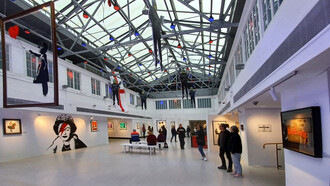A recent volume dedicated to the muses that guided the lightning star of Egon Schiele (Tulln an der Donau, 1890 - Vienna, 1918) was the starting point for me to return to paths that I have trodden several times during my art history studies.
I unusually start from a personal experience because it has been a long time since I read a well-orchestrated fictional biography such as ‘The Flames’ by Sophie Haydock that forced me to (re)think about the central figure that the artist, originally from Tulln in Austria, had, has and will continue to have on the figurative arts in toto.
A hypothetical voyage of (re)discovery can begin between the pages of Haydock's first work and continue between those by Rudolf Leopold his monographic work: ‘Egon Schiele, Paintings – Watercolors – Drawings’ published by Hirmer in 2021. The book is an extensive excursus of the works by the Austrian genius, who - in just twenty-eight years of life - left us thousands of drawings, graphic works and paintings.
The emphasis is put on the impossibility of separating Schiele from the Viennese art-historical context of the time, particularly at the dawn of 1918, when, after Klimt's death, Egon was unanimously labelled as his spiritual successor. According to Klimt himself, the young prodigy's talent was unprecedented.
A highly introspective technique used for paintings that challenges the viewer with an intensity destined to increase over time. This is the astonishing aspect of his work underlined by Leopold, who reconstructs his entire biography and career. Schiele's works, often self-portraits, or portraits of the women closest to him: his sister Gertrude, his ex-lover Wally, his wife Edith and his sister-in-law Adele are characterised by increasingly angular strokes outlining a unique and unattainable style, with sharp lines that spare neither the still lives, the portraits nor himself. He also used body language in his brushstrokes, which are full of vibrant and convulsive eros with bodies that writhe and become one with their own folds, amid shadows and bruises.
‘Seeing is not looking. It is something more,' Schiele wrote in 1911.
In front of his works, among the rooms of the Leopold Museum in Vienna (repository of the richest collection of Schiele's works in the world) we can try to understand his words and the reasons for a fascination lasting for over a century.
It is good to start - first of all - with a superb permanent exhibition (and related in-depth catalogue) dedicated to Vienna in 1900. The itinerary unfolds, illustrating the exploits of Rudolf Leopold (Vienna, 1925 - Vienna, 2010) and his astonishing collection, which came into being in the 1940s when he was in his early twenties. Superb are his exploits and all to be enjoyed between the rooms and between the lines (also availing oneself of Diethard Leopold's annotated biography of his father, published by Hirmer in 2018). ‘Vienna 1900’ is the right compendium to one of the most important museums in the world as it focuses on the sharp change of direction brought about by the 20th century.
A philosophical, scientific and cultural change destined to radically alter the perception of the self, with a triumph of sadness and anguish finding free expression in all the arts, no longer separate entities but total and all-embracing ones.
With over 8,000 works, collected over a period of fifty years, the Leopold Museum presents masterpieces by Klimt, Gerstl, Kokoschka, Moser, Kubin and - of course - Schiele.
The monographic catalogue that accompanies the permanent exhibition opens, evocatively, on a charcoal dated 1906 (Egon was 16 years old) depicting a bust of a woman that fully demonstrates the artist's academic skill, in the perfection of the proportions.
The years follow and give us the opportunity to admire the still lives (more alive than ever) with bold flowers for a completely personal interpretation of Jugendstil.
The radical nudes leave no escape in their breathtaking beauty twisted and sublime, full or devoid of colour as is the case with ‘The Green Hand’ of 1910, a striking drawing where the hand in the foreground seems detached from its context, almost 'detached' from the rest of the body.
The stylistic research continues under the banner of exaggeration and contrast.
‘The Dead Mother’ (1910) with its play of chiaroscuro and colour, darkness and light, peace and anguish, life and death. ‘Moa’, a magic box containing movement, plays of colour and a sharp contrast between realism and abstractionism. The shocking beauty of ‘Small Tree at the End of Autumn’ symbolises man's feeble destiny, as if to evoke his own, imminent end.
‘The Self-Portrait with Chinese Lantern’ (to be observed together with the ‘Portrait of Wally’) is impossible to narrate, one must 'listen' to it in its apparent stillness and unaltered ferocity.
One visit (and, perhaps, not even one lifetime) is not enough to store the details of works beyond the eternal. A shiver runs through the spectator in the presence of the works dated 1918, the year in which Schiele died (a few months after Klimt and after having created the poster for the Secession Exhibition) after his wife, who was six months pregnant, due to the Spanish flu epidemic.
It is the frisson of awareness that transfigures the death of the man and allows genius to turn into legend.
Until 10th September, the Leopold Museum also hosts ‘Amazing’ an exhibition of the Würth Collection. The Würth Collection is among the largest private collections in Europe and one of the most eminent compilations of artworks worldwide. Uniting works from Classical Modernism to contemporary art, according to the Museum the Leopold’s Director Hans-Peter Wipplinger was given carte blanche to select 200 masterpieces from the approximately 20,000 works comprised in the collection and to show these highlights from the Würth Collection on two exhibition levels at the Leopold Museum with artists including: Max Liebermann, Max Pechstein, Ernst Ludwig Kirchner, Edvard Munch, Gabriele Münter, Paula Modersohn-Becker, Ferdinand Hodler, Camille Pissarro, Alfred Sisley, René Magritte and Oskar Schlemmer, among others.















